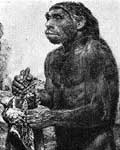Archaeologists attempt to solve Neanderthal mystery
 40 000 years ago the human race was represented by two distinct categories: Homo Neandertalensis and Homo Sapiens.
40 000 years ago the human race was represented by two distinct categories: Homo Neandertalensis and Homo Sapiens.
They did not differ much in appearance. However, judging by the DNA analysis, they could not have had common offspring. Neanderthals had a completely different skull structure; they were involved in primitive social groups and used manual labor to ensure survival. The two types managed to coexist rather peacefully. Then suddenly, something happened; something that not even scientists can clearly explain. Suddenly, Neanderthals completely disappeared from the earth's surface.
Finally, the time has come to solve the mystery.
Neanderthals were named after a small village “Neanderthal” near Dьsseldorf after archaeologists unearthed first remains of our closest ancestor in 1856. It is of utmost importance to solve the greatest mystery of all times, to determine the actual cause of Neanderthal's extinction. It will help us to determine what potential threats human beings face nowadays.
A team of archaeologists, anthropologists, geologists and climatologists headed by professor Tierd van Andel from Cambridge attempted to decipher the mystery evolving around Neanderthals. Scientists decided to synthesize a major database containing biological, ecological and sociological data of the middle Paleolithic era 20-40 000 BCE.
Back then the human race had been living in the Stone Age. However, those early humans were not totally wild. They buried their relatives, placed tombstones on their graves. They took care of their sick, knew how to make fire. They did not build shelters and weren’t much of farmers either. Judging by their stone tools it can be concluded that Neanderthals had very well developed hand muscles; they also had opposable thumbs, which is a sign of delicate hand manipulations. They could not talk however.
In addition, the team traced migration patterns of both types of hominids. They also used modern models of climate and radio metrical dating technique to determine settlements of the early humans. A total of 400 of settlements have been excavated and examined across Europe.
One of the most common versions of Neanderthal’s extinction talks about that fact that they were simply destroyed by their competitors. Why not? After all, early humans were cannibals. Physically however, Neanderthals were stronger than our direct ancestors.
Neanderthals used to inhabit earth for nearly a quarter million years. As for Europe, they lived there for hundreds of thousands of years. As for Europe, Neanderthals lived have been living there for hundreds of years until one day they were faced with their main competitor from Africa.
Van Adlen's team concluded that Neanderthals did not have proper clothes in order to survive global temperature. They started moving southward. According to numerous archaeological finds, it was around this time that the early human made an attempt of interspecific hybridization. However, biology cannot be fooled. Such offspring was doomed from the start. 30 000 years ago the temperature dropped to minus 10 C. The cold was unbearable for those Neanderthals. The last Neaderthal (29 000 years old) was unearthed in Pyrenees. His height was 180cm and weight—almost 100 kilos.
Sergey Leskov, Izventia Nauki
Subscribe to Pravda.Ru Telegram channel, Facebook, RSS!




